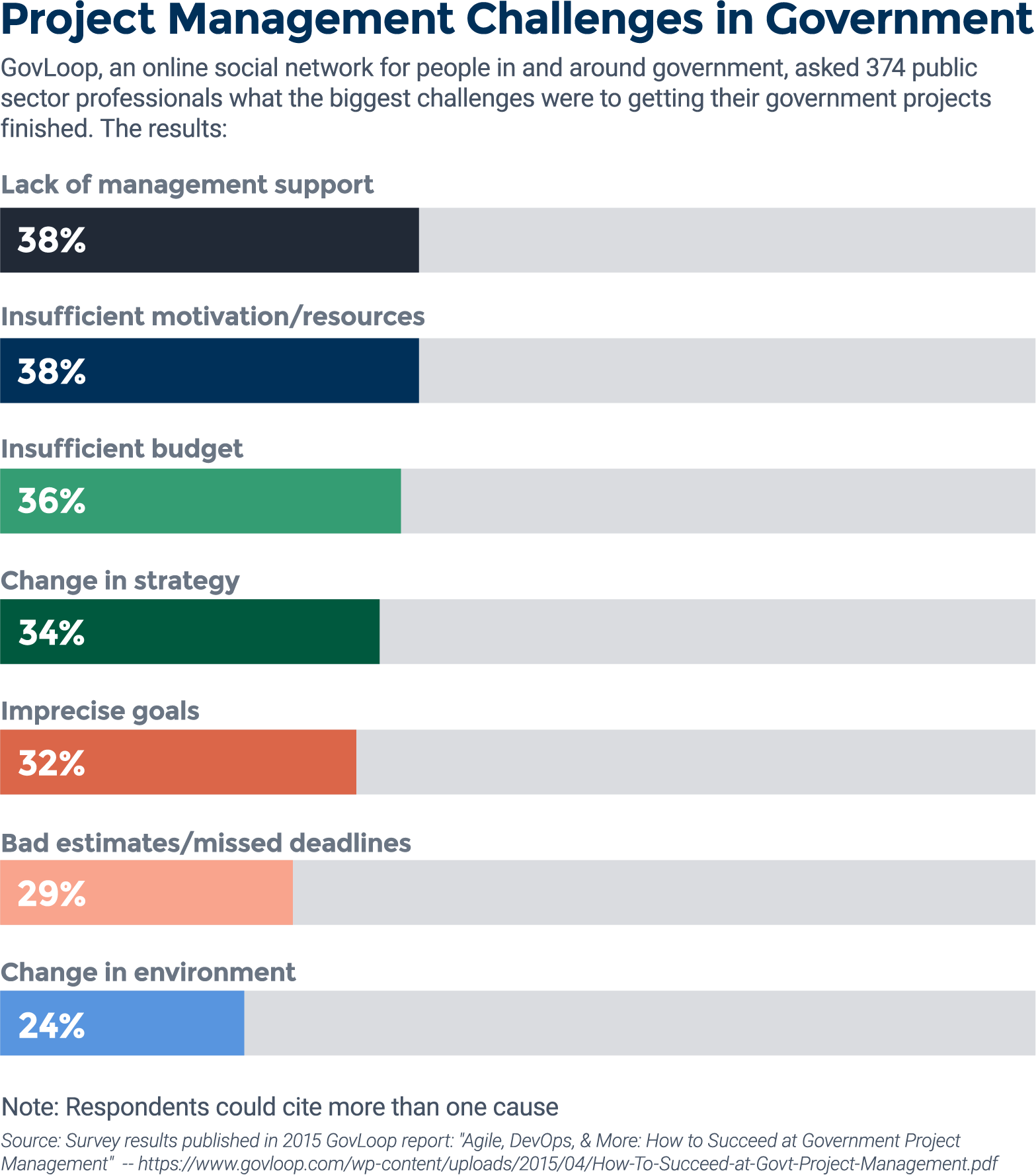The Role of Project Management in Government
While government workers have used project management in project-based work for 50 years, they have increasingly used PM to drive public sector work forward in recent decades. Today, project management is used in all sectors and levels of government.
Below are some details about project work and project management within government agencies:
- Many people, including congressional leaders, political appointees, government workers, and citizens, advocate for improved and more efficient government operations. Most government improvement initiatives use project management to improve government operations.
- Many government projects today must deliver value in a limited amount of time and with limited resources, due to cutbacks in funding for various government agencies.
- Government agencies increasingly employ the principles of project management. But like all organizations, they still often waste significant money on inefficient project work. The Project Management Institute’s 2020 Pulse of the Profession report found that all organizations, including government organizations, waste 11.4 percent of each dollar invested in projects through poor performance — that’s $114 million for every $1 billion invested.
- Several trends contribute to the increasing use of project management in government:
- The size and responsibilities of some government agencies create complexities that require strong project management.
Yad Senapathy is founder and CEO of the Dallas-based Project Management Training Institute, which offers bootcamps to help professionals get their Project Management Institute certifications. Many of his company’s clients have included government agencies and their workers.
Senapathy reiterates that the size and complexity of many government agencies demand improved PM. “The DOD (U.S. Department of Defense) alone employs 3.2 million people,” he says. “You can imagine the complexity. That complexity alone demands project management. If you do not have a structure appropriate to deal with this complexity, you are going to waste a lot of money.” - Government agencies are outsourcing more work to private contractors, which requires government workers to manage the contractors, along with government employees, to move projects forward.
- Government organizations want to use effective project management to demonstrate their own value and viability.
- Project management provides a framework for better customer service, which is increasingly important within government agencies.
- As in private industry, government organizations need to give the public around-the-clock secure access to data, which requires more efficient work.
- The size and responsibilities of some government agencies create complexities that require strong project management.
Yad Senapathy is founder and CEO of the Dallas-based Project Management Training Institute, which offers bootcamps to help professionals get their Project Management Institute certifications. Many of his company’s clients have included government agencies and their workers.
Senapathy says people wrongly perceive that good project management isn’t as important in government because it isn’t profit-driven, unlike private industry. “It is a misconception that project management is necessary only where profitability matters,” he says. “The government has similar responsibilities to the taxpayer. For every tax dollar that’s paid, you are accountable. The deal is everyone is eventually accountable. There is no free lunch.”
In fact, Senapathy says, “I think it is even more critical for the government to be invested in project management than private enterprise. Government projects are subjected to microscopic scrutiny from individual citizens in informal forums to formal congressional hearings.”
Stephen Townsend, Director, Network Programs, for the Project Management Institute, says the government must deliver value for its citizens, just as corporations do for shareholders. “That value can be through national security, roads, and infrastructure or service programs,” he says. “A strong project management discipline helps government deliver the right solutions efficiently and effectively.”
Project Management Guide
Your one-stop shop for everything project management

Ready to get more out of your project management efforts? Visit our comprehensive project management guide for tips, best practices, and free resources to manage your work more effectively.
Benefits of Government Project Management
Here are some additional benefits of good project management for government operations:
- It provides insights into whether a project is worth taking on.
“If the project has little likelihood to succeed or represents a highly risky venture, a good business case and review process can stop agencies from making poor investments,” says Townsend. - It puts in place structures that enable teams to do work consistently across all projects and throughout the organization.
- It increases efficiency in responding to disasters or disturbances, including a pandemic.
“In terms of the pandemic, having a consistent organization process allows for a seamless integration of work,” says Senapathy. “What if project management didn’t exist? The government entities and employees would all be scrambling.”
Project management work and philosophies “allow us not to be reactive but proactive,” Senapathy says. “This pandemic has been the single biggest example of how quickly this country can respond ... Project management can do brilliant things.” - It helps avoid the reinvention of project tools and techniques for each project that you take on.
- It provides workers with access to past data, past work, and best practices in project management, which helps ensure more consistent and better project execution.
- It monitors whether project deliverables are completed (and on time).
- It helps employees understand their responsibilities in completing the work.
- It helps project teams and leaders report on progress to agency and government leaders.
- It offers a structured proving ground for new project management strategies.
- It allows agencies to better adapt to new technologies, because they become part of structured project management.
- Project work can affect a range of stakeholders, including many outside the government agency doing the work. Good project management allows workers to better communicate with those stakeholders and address concerns.
- It allows people to better understand effective ways to solve problems.
Challenges of Government Project Management
Workers will encounter a number of challenges to managing government projects, including poor support from government leaders, government rules that impede the work, and limited money for worker training.
Here are some challenges to good government project management:
- Limited Knowledge about Project Management Principles: For years, government agencies inconsistently used standard project management principles in their work. Today, more government workers understand project management, but many senior managers still have limited knowledge that can affect how they deploy project management.
- Poor Institutional Support: Because of limited knowledge, leaders of government agencies may not understand the value of project management. This means many agencies offer little financial support or other resources.
- Instability of Sponsorship: Government tends to experience high turnover in agency leadership, and elections can bring in newly elected leaders to oversee these agencies. All of this change can hinder progress on government projects.
- Rules and Regulations Constraining the Work: Rules often govern overall work and project management in private industry, but leaders and workers can bend many of those rules to help the project succeed. (To learn more about compliance management, visit “Compliance Management: The Rules for Success.”) But in government, organizations must follow those rules, as they often carry the authority of law.
“For example, there are laws and rules associated with conflict of interest, promoting competition through fair procurement processes and transparency in performance reporting,” says Townsend. “Those requirements, though, come at a cost. It may take longer to complete certain tasks. There may be mandated reviews or checkpoints. There may be periods for public review and comment — which if missed or shortchanged, could prompt legal challenges. Government project leaders have to learn to navigate those requirements to which their corporate counterparts may not be subjected.” Josh Ramirez, President of the Institute for Neuro & Behavioral Project Management, says those regulations and rules then can influence the overall focus of government employees. “That becomes their area of emphasis,” he says. “That’s what they have to focus on, so that’s what they put their energy into.”
So when a manager suggests a method to move work forward that doesn’t fit in a traditional box of what workers think is acceptable, “sometimes [that idea is] resisted,” he says. “Sometimes, that’s even considered out of scope.” - Agency Employees Dispersed Geographically: Some government agencies have employees in a number of geographically separate offices, which can make overseeing a PM team more difficult. (This may be more common in government than in the private sector.)
- Government Hiring and Employment Policies: To complete a project, team leaders may rely on specialists drawn from different areas within an agency or with other agencies. Government hiring and employment policies can make that difficult.
- Less Effective Collaboration within Agencies and Departments: It’s not unusual to have structures within private companies that impede collaboration, but that tendency is more pronounced within and among government agencies.
“The interplay between various departments is much more synchronous in private industry than in government,” says Senapathy. “The interplay doesn’t work as efficiently [in government].” - Overall Bureaucratic Environment: Even beyond identifiable rules and regulations, government agencies often operate in an environment where written and unwritten rules dominate all processes. This means they are often resistant to change or quick action on problems.
- Employees Who Don’t Understand or Use Project Management Lexicon: Project management training allows workers to understand common language pertaining to effective project management. Government employees can be ignorant of or resistant to that language.
“Integrating modern project management lexicon into an established culture of business language that has been in use for decades presents unique challenges of organizational change management,” says Senapathy. - Incremental Thinking Is the Norm: Governmental agencies often only accept slow or incremental change, if any at all.
- Ingrained Processes and Tools: Governments often lack the drive that exists in many private companies to continuously innovate to improve their tools and processes.
- Minimal Funds for Training: Government agencies might have limited funds to train leaders in project management. Those funds often are also the first to be cut when budgets need to be pared down.
“Prioritizing training for program management roles across several leadership levels and multiple business lines may be a significant challenge since the education-related budget is one of the earliest victims of belt-tightening,” says Senapathy.
How Good Project Management Can Bring Positive Change in Government
Good project management can do more than bring about successful projects. It can change how government works, increase flexibility, and engender a culture of innovation within government agencies.
Here are some significant ways that project management can change government agencies:
- Project Management Can Be a Lever of Change: Many government agencies are change-averse. Good project management inherently brings about positive change. Team members should recognize their potential role as change agents.
- Project Management Increases Flexibility: As mentioned above, government agencies often operate within bureaucratic, inflexible environments. But good project management should allow agency leaders and employees to make needed adjustments in how they plan and execute work.
- Project Management Fosters Innovation: Government agencies are increasingly looking for ways to better serve the public. Much of that government innovation springs from project management. An example is a new employee incentive program in the federal government called Securing Americans Value and Efficiency (SAVE). The program rewards employees who come up with ideas that improve efficiencies and save money.
How to Implement a Project Management Culture in Government
It can be challenging to implement a project management culture in government. But, management leaders can do it — they just have to focus on everything from education and training to the development of methodologies to appropriate oversight.
First, federal agencies should be aware of job candidates with a Project Management Professional (PMP) certification from the Project Management Institute. The certification recognizes a level of knowledge and expertise in project management. Many project managers, in private industry and government, have that certification.
ESI International, a Virginia-based project management training company, has identified several other steps to implement project management within a government organization, including the following:
- Education and Training: Proper worker education and training provide the foundation for the cultural changes that can foster good project management.
- Maturity and Capability Assessments: Organizations must assess and understand their strengths and weaknesses in doing project management work. They should also make improvements where needed.
- Methodology Development: Leaders must create and follow consistent methodologies that guide how workers tackle a project. Doing so can help workers avoid having to reinvent processes and tools for every project.
- Project Execution Support: Organizations must support project managers in the work on actual projects. This might include hiring experienced coaches and mentors who can transfer their knowledge to workers so that they help projects succeed.
- Center of Competence: A centralized office can provide strategic oversight to projects throughout a government agency. It can also provide project management expertise and support.
- Strategic Oversight: Top leaders in an organization must stay involved in the organization’s project management process. They can make sure the organization’s projects align the organization’s overall goals.
What Is Earned Value Management in Project Management?
Earned value management is a method that tracks how much work has been accomplished on a project and how much of the budget has been spent on a project at any point.
Earned value management is an important part of project management in government and often required in federal government projects. The Department of Defense and NASA has used earned value management since the 1960s.
Using this method, PMs track total project work finished, along with hours and money spent on a project. They can then compare that to the total project budget. That allows team members to assess whether they are ahead of or behind schedule. And it allows them to assess whether they are over or under budget in their spending.
“Earned value management is one of the higher-emphasized areas in all of government project management,” says Ramirez. “That’s how you get visibility into what’s going on.”
A Program Management Framework to Help Guide Federal Technology Purchases
In 2015, the Project Manage Institute published a white paper that offers guidance and a framework for how federal agencies can use project management to improve the way they buy new or modify existing computer systems. You can read more about the PMI Standards Framework.
Common Project Management Frameworks
| Framework | Characteristics | Type of Projects Best Used For |
|---|---|---|
| Projects in Controlled Environments (PRINCE2) | Highly structured, detailed upfront planning | Well-defined projects that are unlikely to need significant changes or adaptations |
| Critical Chain Project Management (CCPM) | Focuses on moving through project phases quickly with no wasted time | Various types of projects |
| Lean | Stresses minimizing waste, in both effort and resources, and often focuses on process improvement | Complex projects in fast-changing environments |
| Extreme project management (XPM) | Very open to plans and schedules changing quickly | Complex projects in fast-changing environments |
| Scrum | Designed for rapid progress, as well as adapting to needed changes and fixes; projects are often broken down into two to four week-long sprints | Projects with ill-defined or intangible deliverables (including software) |
| Waterfall | One of the oldest and most traditional project management approaches; requires project to be planned beginning to end (each phase of a project begins only when previous phase is completed) | Well-defined projects that are unlikely to need significant changes or adaptations |
Regulations, Guidelines, and Certifications for Federal Government
In 2016, the federal government approved a law to improve project management in federal work, established other regulations governing project management, and has created a special certification for government managers who prove their competence in project management. All of these are detailed below.
Program Management Improvement Accountability Act
In December 2016, President Obama signed into law the Program Management Improvement Accountability Act (PMIAA). In June 2018, the federal Office of Management and Budget issued Memorandum M-18-19 that established the federal government’s initial guidance to federal agencies in implementing the law. The law aims to ensure that federal workers use proven practices in managing programs and projects throughout the federal government. It achieves the following, among other goals:
- Sets up a framework to improve policy, staffing, and training in program and project management
- Ensures that management leaders conduct reviews of programs and projects to make sure they are well-managed
- Coordinates the development of policies and processes to continually improve project and program management
Project management leaders make a distinction between management of projects and programs. In this context, a project is a defined amount of work that an organization’s employees do to create or modify a product or service. A program is a group of related projects and operational activities. Managers coordinate these projects and activities to provide more overall benefit than if employees had managed them separately.
Procurement Regulations in Project Management
The federal government mandates certain actions in project management when it involves purchasing assets for the government, including buying or modifying computer technology. Regulations include the Federal Acquisition Regulation and the Federal Acquisition Streamlining Act.
The Federal Acquisition Certification for Program and Project Managers
The federal government has established a special certification through which federal managers can prove their competence in program and project management. The certification is called the Federal Acquisition Certification for Program and Project Managers (FAC-P/PM). The certification is recognized by all federal agencies, except for the Department of Defense.
The certification focuses on essential competencies needed for program and project managers.
It offers three levels of certification:
- Entry/Apprentice: This level means the person has the ability to manage low-risk and simple projects.
- Midlevel/Journeyman: This means the person has the ability to manage projects with low- or moderate-level risks. The person also can apply basic management practices to projects.
- Senior/Expert: This person can manage and evaluate moderate to high-risk programs and projects. The person has significant knowledge and experience in project management practices.
California Project Management Recommendations for State Workers
Some states offer specific guidance about project management to state employees. The California Project Management Office, for example, has created a 461-page document providing a framework for project management in California state agencies. The document provides guidance and insights on project management methods. You can read the official documentation for more information.
Examples of Successful Government PM Implementation
Local, state, and federal government agencies have used project management to successfully complete tens of thousands of projects. Here are just a few examples:
- Michigan Office of Project Management: The state of Michigan’s information technology projects were often behind schedule, over budget, or both. To change that, the state created an Office of Project Management and built an infrastructure that helped establish a project management culture with state workers. Then leaders built a project management support structure to help all state government agencies, which allowed the state to integrate project management into much of the state’s daily business activities. To learn more about the project, visit “Implementing a project management culture in a government organization.”
- New Orleans VA Hospital: In 2005, Hurricane Katrina destroyed thousands of buildings in New Orleans, Louisiana. Among those buildings was a Department of Veterans Affairs hospital complex where doctors and other medical providers trained medical students, conducted medical research, and served 40,000 military families.
In 2006, Congress approved funding for a replacement complex of buildings that would encompass 1.6 million square feet. From the beginning, project leaders focused intently on understanding risks to the project, listening to stakeholders, and preventing inefficient changes in scope.
They finished the three phases of the hospital complex on time, and the project’s final cost was 14 percent under budget. To learn more, visit “Department of Veterans Affairs Realizes Benefits through Improved Healthcare for Veterans.” - Department of Justice Website: By 2014, the U.S. Department of Justice website included more than 450,000 web pages, documents, and files. Lawyers, law enforcement officials, and many other citizens valued the information provided. But more than 100 offices of the department needed to maintain their own sections of the website using a wide range of processes and technologies. The website was becoming a huge burden to maintain.
The Department of Justice’s project team decided to use a Scrum Agile methodology to rebuild the website in increments. The first job in the project was to build a website content management system and launch one section of the website. Eventually, there would be 120 sections in 12 major version releases.
The incremental approach allowed website users to provide feedback on the first release, which became input on making changes in the second and later releases. Each release provided users with more functions, and each took less time to finish. To learn more, visit “Case Study: Agile Government and the Department of Justice.”
Best Practices and Expert Tips for Effective Government Project Management
Experts offer a number of recommendations that can help leaders and workers to perform effective project management. Tips include requiring the buy-in of top organization leaders, understanding risks at the beginning of the project, and employing a mix of strategies.
Here are some additional expert recommendations and tips:
- Seek Top Leadership Buy-In for the Structure and Strategies: Organization leaders need to understand the principles of good project management and approve the overall strategies to get projects done. Without that, financial and other support for the work will be tentative and can be abandoned at any time. Support from organization leaders will also translate into more support from employees throughout the organization.
“The buy-in (for the project and processes) should start at the top and not at the bottom,” says Senapathy, from the Project Management Training Institute.
“The government needs to emphasize the discipline of project management from the top down,” says Ramirez, from the Institute for Neuro & Behavioral Project Management. “And it has to be a focused area — just as focused as safety, cost management, the production of the technical product you’re delivering or building.” - Think about and Listen to All Stakeholders That the Project Might Affect: A wide range of people might be affected by a project — beyond one agency and even beyond the end-users. It’s important to understand everyone who might be affected and how they might react to the work.
“Stakeholders represent any individual or group who is affected by or perceives themselves as affected by the project and its outputs,” says Townsend, with the Project Management Institute. “Stakeholders can affect every aspect of a project, including its plans, costs, and schedule. Understanding who the stakeholders are, how to engage with them, and how to balance potential conflicts among them is important.” - Create a Plan and Provide Clear Direction Before You Start: If you’re using Agile methodologies to move forward a project, planning will likely be different from other project management methods. In any case, you need to set broad goals and make sure your team understands those goals.
“Starting too early can mean that goals are unclear or misunderstood (and) key requirements get missed,” says Townsend. “Good, upfront planning with regular reviews of the plan through the project lifecycle can make a big difference in success rates.” - Monitor Progress Well: Especially in more traditional project management, it’s imperative that the team monitors benchmarks, deadlines, and progress.
- Made Quick Adjustments Based on Monitoring: Your team must quickly make adjustments if your monitoring shows missed benchmarks or deadlines or other issues. This is especially true in government projects that could involve large budgets.
“The sooner you catch things, the better you are in preventing (problems) and the draining away of millions of dollars,” Senapathy says. - Be Selective: Don’t try to perform a wide range of projects that affect many agency operations all at once. Pick projects, and get leadership buy-in, that can improve operations in a specific area. That way you don’t cause chaos throughout your organization.
- Envision Your Success: Envision and articulate a path toward the project result and what that result will look like. You can do that in part through setting down the scope of the project.
- Make Sure Your Project Provides What the Intended Beneficiary Needs: “Most important, good project management ensures that the result meets the needs of its intended beneficiaries,” says Townsend. “If a result is produced quickly with all of the promised features but fails to meet the needs of the people who will use that result, the project has failed.”
- Bring Together Your “A-Team”: Pick some of your organization’s brightest minds to be part of the project team — even if their job description doesn’t suggest they fit. The brightest minds can envision bigger goals and foster real innovation.
- Integrate Employee Development and Career Goals with Project Management: Employees will respond more intently to project work when their job descriptions and rewards are influenced by their project management work.
“There’s got to be motivation from individuals to take greater responsibility” for project success, Senapthy says. - Think about Behavioral Economics and the Science of Human Behavior: Progress on any human work must take into account how humans make decisions, says Ramirez, from Institute for Neuro & Behavioral Project Management.
“We don’t focus enough on the behavioral piece,” he says. “Progress in the government, private sector, or any organization is going to be slower when you do not incorporate the human factors that go into it.” That means organizations must think about why people make the decisions they do, including financial incentives, job security, and agreeing with superiors. - Know the Risks Involved in Your Project: At the outset of every project, project leaders and team members need to assess the risks and challenges inherent to the project. From there, make adjustments or take other measures to deal with those risks.
“Risk management considers factors that can negatively or positively impact a project and its results,” says Townsend. “Some risks can derail projects while others may enable teams to accelerate or increase value delivery. Good risk management keeps those threats and opportunities visible throughout the project so the team can mitigate risks and take advantage of opportunities.
”Ramirez says some risk analysis doesn’t go far enough in acknowledging human factors, however. This includes a disincentive to acknowledge risks in some areas, like how a risk might affect their jobs, or the opinions and views or their superiors in the agency.
“There are many incentives to avoid considering additional risks,” Ramirez says. Those disincentives must be dealt with and considered by project leaders, he says. - Start Small, and Scale Up: If your agency is just starting to deploy formal project management, start with a smaller project. Testing the process on a smaller or shorter-term project will allow team members to understand and tweak processes before moving on to a bigger project.
- Be Nimble and Willing to Employ a Mix of Strategies: “A real-life project needs to be nimble,” says Senapathy. That might mean that project leaders use a traditional project management framework, like Waterfall, for one portion of the project, and then use an Agile-based Scrum framework for another portion. “Keep the processes flexible,” he says. (To learn more about different project management methodologies, visit “What's the Difference? Agile vs Scrum vs Waterfall vs Kanban.”)
“In general, since projects never fall into a theoretical bucket of a framework, it is perfectly fine to mix and match traditional and agile methodologies to gain maximum performance from available budget and schedule,” says Senapathy.
Streamline Project Management in Government with Smartsheet
Empower your people to go above and beyond with a flexible platform designed to match the needs of your team — and adapt as those needs change. The Smartsheet platform makes it easy to plan, capture, manage, and report on work from anywhere, helping your team be more effective and get more done. Report on key metrics and get real-time visibility into work as it happens with roll-up reports, dashboards, and automated workflows built to keep your team connected and informed. When teams have clarity into the work getting done, there’s no telling how much more they can accomplish in the same amount of time. Try Smartsheet for free, today.




